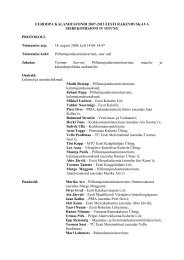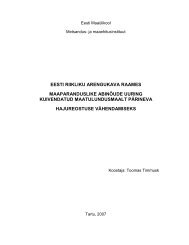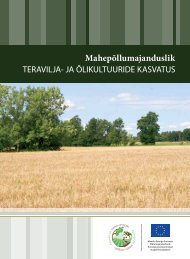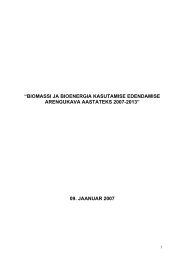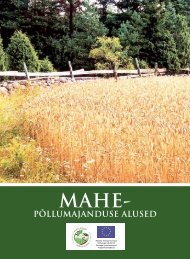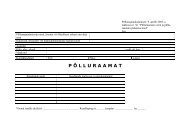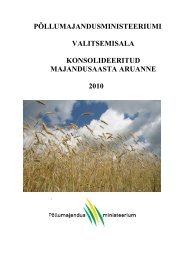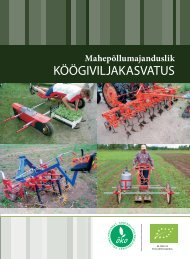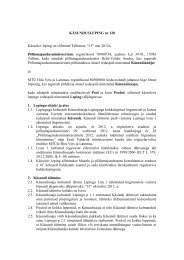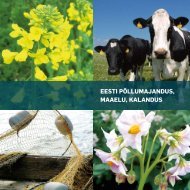estonian agriculture, rural economy and food industry
estonian agriculture, rural economy and food industry
estonian agriculture, rural economy and food industry
You also want an ePaper? Increase the reach of your titles
YUMPU automatically turns print PDFs into web optimized ePapers that Google loves.
4.<br />
smaller enterprises (up to 40 ha), 93.1% of grains<br />
were sold <strong>and</strong> the remainders were used for the<br />
farms' own needs. The marketing opportunities are<br />
better for large enterprises, as the production quantities<br />
are larger. The average price paid to producers<br />
for grains was 1.42 EEK/kg.<br />
Analysis carried out by researchers of the<br />
Estonian Research Institute of Agriculture shows<br />
that grain production in Estonia is profitable at the<br />
average producer prices (1500-1700 EEK/t) if the<br />
yield is at least 4000 kg/ha. On smaller farms, production<br />
costs can be cut by cooperating in machine<br />
use or purchasing second-h<strong>and</strong> machinery.<br />
Estonia covers its <strong>food</strong> potato dem<strong>and</strong><br />
Potatoes are grown in Estonia mainly on small<br />
farms <strong>and</strong> private residences, <strong>and</strong> to a lesser extent,<br />
in larger agricultural enterprises (Table 4).<br />
The area used for potato production has<br />
decreased in recent years. Total area for potato production<br />
in the year 2000 was 30,900 ha. The total<br />
yield was 471,661 tonnes with an average yield of<br />
15.6 t/ha. In the year 2001, the total area for potato<br />
production decreased with a yield of 345,230<br />
tonnes; the average yield was 16.1 t/ha.<br />
The <strong>food</strong> potato dem<strong>and</strong> (120,000 – 140,000<br />
tonnes) is fully met. The seed dem<strong>and</strong> for 30,000<br />
ha is approximately 140,000 tonnes; industrial<br />
potato dem<strong>and</strong> is 10,000 tonnes, <strong>and</strong> 100,000<br />
tonnes of potatoes is needed for starch production.<br />
Oil crop <strong>and</strong> flax production<br />
are developing<br />
The crop area used for oil crops in 1990 was 1000<br />
ha; in 1999 it was at 24,100 ha. A vegetable oil<br />
plant was commissioned in Estonia in 1999, which<br />
improved the marketing opportunities of rapeseed<br />
<strong>and</strong> turnip rapeseed. A portion of both oil seeds<br />
was exported to Finl<strong>and</strong> <strong>and</strong> Denmark.<br />
While in 1990 flax was grown mostly for fibre<br />
production, more recently the focus has been<br />
toward oil flax production. Fibre flax production in<br />
Estonia is almost non-existent, which is primarily<br />
because Estonian flax cannot compete on the market<br />
with state subsidised flax from other European<br />
countries, Latvia, <strong>and</strong> Lithuania.<br />
Flax was sown in 2000 on 325 ha, of which 275<br />
ha was oil flax, <strong>and</strong> only 50 ha was fibre flax.<br />
Domestic horticultural products<br />
are preferred in Estonia<br />
The development of Estonian horticulture has been<br />
influenced by the population's preference for<br />
domestic quality fruits, vegetables, <strong>and</strong> berries.<br />
Interest from foreign countries in Estonian<br />
products has also increased.<br />
Almost one-half of all horticultural products<br />
produced in Estonia are grown in small gardens.<br />
FIGURE 1.<br />
12%<br />
TABLE 3.<br />
1990<br />
1991<br />
1992<br />
1993<br />
1994<br />
1995<br />
1996<br />
1997<br />
1998<br />
1999<br />
2000<br />
Area under cereals (%) in size groups of<br />
agricultural enterprises in 2000 (ha)<br />
25%<br />
(Source: ESO)<br />
Rye<br />
65 900<br />
58 500<br />
59 200<br />
61 900<br />
21 700<br />
32 000<br />
31 600<br />
34 300<br />
38 800<br />
24 258<br />
28 937<br />
22%<br />
8%<br />
Winter<br />
wheat<br />
21 200<br />
17 200<br />
26 800<br />
32 700<br />
15 400<br />
13 400<br />
17 200<br />
17 800<br />
19 400<br />
13 052<br />
21 736<br />
10%<br />
23%<br />
Up to 10 ha<br />
10,1–50<br />
50,1–100<br />
100,1–300<br />
300,1–500<br />
Over 500 ha<br />
Source: Review<br />
2000/2001<br />
Agriculture <strong>and</strong><br />
<strong>rural</strong> life<br />
Areas under grains (ha)<br />
Summer<br />
wheat<br />
4 800<br />
7 000<br />
16 700<br />
17 600<br />
18 800<br />
25 200<br />
28 700<br />
33 100<br />
47 400<br />
53 062<br />
47 233<br />
Barley<br />
263 700<br />
284 800<br />
268 200<br />
218 100<br />
217 900<br />
186 500<br />
148 000<br />
165 700<br />
166 800<br />
153 955<br />
165 672<br />
Oats<br />
33 400<br />
42 300<br />
41 700<br />
35 700<br />
36 100<br />
38 500<br />
49 000<br />
54 400<br />
61 000<br />
60 976<br />
53 345<br />
Buckw<br />
heat<br />
0<br />
13<br />
4<br />
0<br />
5<br />
42<br />
80<br />
41<br />
57<br />
63<br />
493<br />
Mixed<br />
crops<br />
8 000<br />
8 300<br />
10 500<br />
9 100<br />
9 600<br />
8 700<br />
14 200<br />
21 300<br />
20 600<br />
15 663<br />
12 531<br />
15



